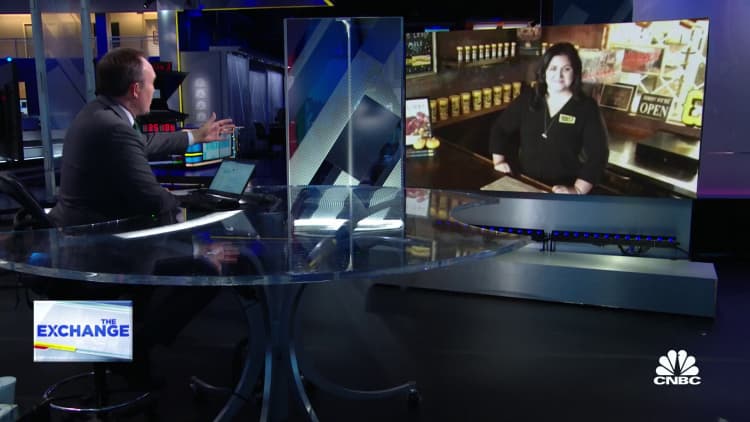
Customers at a McDonald’s restaurant
Scott Mlyn | CNBC
As the restaurant industry battles inflation, the large size of chains and their access to cash gives them the upper hand, but independents have advantages of their own when managing higher costs.
Feeling the pressure on their budgets, consumers have been cutting back on their restaurant visits in recent months. Monthly same-store restaurant traffic has been shrinking compared with the year-earlier period for eight consecutive months, according to industry tracker Black Box Intelligence. In response to that drop-off, both chains and independents are working to address the cost factor without alienating diners.
Prices for food consumed away from home have risen 8.6% over the last 12 months, as of October, according to the Bureau of Labor Statistics, as restaurants raise menu prices to address the soaring costs for ingredients, labor and even energy.
Aaron Allen, founder and CEO of restaurant consultancy Aaron Allen & Associates, compared restaurant chains to oil tankers and independents to speedboats. Chains have bigger budgets, broader scale and other tools like advanced technology. But they’re also often slow to act and mired in bureaucracy.
A mom and pop restaurant, on the other hand, doesn’t have the same access to cash or the benefits of size but can move more quickly to make changes.
Scale matters
When it comes to inflation, restaurant giants like McDonald’s and Starbucks have some obvious advantages over independent burger joints and coffee shops. Their massive size helps chains lock in prices early when buying ingredients from suppliers, and they can often apply pressure to receive more favorable contracts.
“If you’re a chain, you’ve got the power of bargaining strength and leverage with suppliers, which is what’s happening,” Allen said. “Independents don’t have a lot of wiggle room to switch suppliers, except for non-core things.”
Of the more than 843,000 restaurants, food trucks and ghost kitchens in the United States, roughly 37% are part of chains with more than nine locations, according to food analytics firm Datassential.
Noodles & Company, which has more than 450 locations, recently signed a deal for its 2023 chicken supply. The company expects the contract will help it save about 2% relative to its third-quarter margin for cost of goods sold.
“As you look through all of the disruption in the supply chain environment, vendors want some level of certainty in terms of purchase quantities, not just price,” Noodles CEO Dave Boennighausen said.
Because chains are placing larger orders, suppliers typically prioritize their orders over those for independent restaurants. Adam Rosenblum, chef and owner of Causwells and Red Window in San Francisco, said uncertainty securing ingredients has caused him to buy two or three times what he normally would when they’re available. And carrying that higher inventory puts more pressure on his razor-thin profit margins.
“I don’t have the buying power, I don’t get to set my prices annually, and I’m just not going through enough product to matter to some of the bigger companies,” Rosenblum said.
In the United Kingdom and other European markets, which have seen even higher inflation than in the U.S., large franchisors have said that they’re providing financial assistance to operators who are struggling to cope with higher costs. For example, McDonald’s executives said in late October that the fast-food giant may offer “targeted and temporary support” to European franchisees who need it.
Independent operators don’t have the same luxury. Kate Bruce, owner of The Buttery Bar in Brooklyn, said she’s been facing higher costs for everything from labor to cooking oil to energy.
“It’s expensive to run a restaurant these days, and ours is small. So these costs matter, and everything is very tight,” she said.
Nimbler and more flexible
On the other hand, independent restaurants have the advantage of speed. If a mom and pop notices much higher prices for a key ingredient in an entree, the restaurant can quickly change prices, slim down the portion size or even remove the item from the menu.
For example, Bruce said that if she raises the price on one item, she likes to add something else to the menu that’s cheaper.
“Yes, we have Wagyu beef, but [we] also have some salads that are a little more affordable and chicken entrees that aren’t going to scare somebody away from coming in,” she said.
Portillo’s restaurant chain CEO Michael Osanloo said independents do have greater flexibility when it comes to changing prices. Fast-food customers expect the same prices at every location, but menu prices can vary based on where the location is and if a franchisee or the company owns that restaurant. “There’s a little bit of price shock,” Osanloo said.
Consumers care more about prices when they’re visiting a chain restaurant, according to findings from a survey of roughly 2,400 U.S. consumers conducted by PYMNTS. More than a third of respondents said everyday prices mattered when picking a chain restaurant, while just 22.5% said it factored into their decision making when selecting an independent eatery.
And while beloved chains have brand recognition and the pricing power that comes from that, independents also earn goodwill from some consumers by virtue of being a small business.
“There’s this perception of authenticity, like a family Italian restaurant versus a big chain like Olive Garden,” Allen said. “That sentiment has started to hurt chains.”








